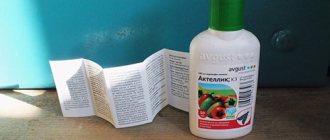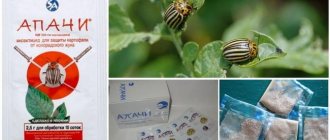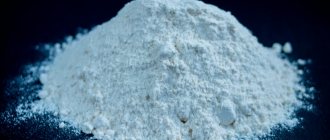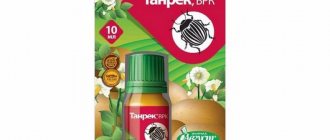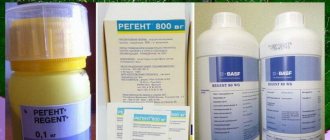Mechanism of action of the drug
When treating cultivated plants with the insecticide Bi 58, the chemical solution directly hits the pests and quickly penetrates the soft tissues of insects (larvae) and their chitinous cover. Dimethoate acts neuroparalytically at the cellular level, causing the death of parasites.
The working solution of the pesticide, prepared according to the instructions, is absorbed by plants during processing and remains in their cell sap for about 25 days. Pests, devouring green plant matter, receive a lethal dose of toxin. This expresses the systemic effect of the drug. Precipitation does not affect its effectiveness.
Application of Bi-58
Are there any analogues of the insecticide?
For dimethoate, the following analogs of “Bi-58” are registered for use in agriculture: “Alfa-Director”, “Binadin”, “Binom”, “Bishka”, “Danadim Power”, “Danadim”, “Di-68”, “Dimetron”, “Dimefos”, “Evrodim”, “Sirocco”, “Tagore”, “Landing”, “Ditox”, “Tarradim”, “Dimet”, “Fostran”, “Kinfos”, “Tibor”, “Dimetoat” -400", "Tod", "Dishance", "Rogor-S", "Rangoli-Duncan", "Dimetus".
“Bi-58” is a well-known powerful insecticide that can be used to treat grains, vegetables, berries, fruit crops, grapes, and flax against a variety of pests. Its action is complex: systemic, contact and intestinal. Because of this, the insecticide has strong effectiveness and a long-lasting protective effect. The drug is compatible with many pest control agents, some of them are even recommended to be used together to enhance the overall effect.
How to breed Bi 58
In small garden plots, 5 ml packaging of the drug is more often used to treat cultivated crops. The instructions for use indicate that to prepare the solution, the pesticide is diluted with water in the proportion: 1 ml Bi 58 per 1 liter of liquid. Increasing the dosage leads to burns of plants: they turn yellow, shed leaves and may die.
Bi-58 consumption in the table
Instructions for use
When preparing to treat plants, you must carefully study the instructions for use of the drug Bi 58. The most important condition is to prepare the solution correctly. To do this, take 5 liters of water into a bucket, shake the ampoule with the insecticide well and open it. The instructions for use recommend diluting Bi 58 at the rate of 1 ml per 1 liter of water.
When using Bi 58, you should first read its instructions for use.
It is better to clarify the exact dosage for each crop in the instructions for use of the product:
- To treat grains, you will need 1 kg of concentrated preparation per 1 hectare of crops.
- For legumes and vegetable crops, the amount varies from 600 to 1200 g per hectare.
- Fruit trees and berry bushes require 1600-2500 g per hectare of plantings.
Treating plants with an insecticide has subtleties that can significantly affect its effectiveness. To achieve maximum results, experts recommend adhering to the following rules:
- The solution that was prepared for spraying is used immediately; it is not recommended to store it.
A solution made on the basis of Bi 58 is recommended to be used immediately after its preparation. - To prepare the insecticide, use only clean water without sand or clay. Excessively hard water can reduce the effectiveness of the drug.
- The best time for treatment is during the active growing season. This is when parasites cause maximum damage to plants.
- It is strictly forbidden to process plantings during flowering.
- Do not cultivate crops in open ground immediately after the end of frost. The best temperature for spraying is from +12° to 35°C. At a lower temperature, the effectiveness of the drug may decrease several times.
The drug Bi 58 partially loses its effectiveness at temperatures below +12 degrees - Some crops require repeated spraying to completely kill pests.
- Ornamental plants should be handled very carefully - there is a high risk of leaf burns.
- During dissolution of the concentrate and when spraying, it is recommended to periodically stir the working solution.
If the technology is violated and the concentration of the working solution is exceeded, serious harm can be caused to the plants - they begin to lose leaves and wither. Instructions for use of the drug Bi 58 New must be followed exactly.
Application of Bi 58
The drug Bi 58 can be used throughout the entire growing season of cultivated plants, with the exception of the last 40 days before harvesting. Pest eggs sometimes remain viable after a single pesticide treatment, so if the plantation is heavily infested with parasites, spraying must be repeated after 2 weeks. The Bi 58 solution prepared according to the instructions is used for the following crops (consumption is indicated for 1 hectare of agricultural land):
| Plant | Its pests | Required amount of drug in liters |
| wheat | bug, grain fly, thrips, aphid | 1,5 |
| barley and other grains | 1,0–1,3 | |
| potato | nematode, Colorado potato beetle, wireworm | 1,6–2 |
| roots | tick, fatty leg | 0,5–1 |
| pulses | weevil, codling moth, aphid, pea weevil | 0,5–1 |
| fruit trees | caterpillar, moth, scale insect | 0,8–2 |
| raspberries | galitza, cicada, tick | 0,6–1,2 |
| grape | wood borer, leaf roller, aphid | 1,2–3 |
Composition and dosage form
Active ingredient: dimethoate , dosage 400 g/l, chemical class: organophosphorus compounds (OP). Preparative form – emulsion concentrate (EC).
Examples of manufactured drugs “BI-58 NEW, CE”
Special instructions and precautions
When using Bi 58 to protect plants from pests, the following safety precautions must be observed:
- All work on preparing the working solution and using the chemical must be carried out in closed shoes, a suit, rubber gloves, a respirator and safety glasses.
- It is recommended to dilute the product with water immediately in a garden sprayer bottle.
- After irrigating the plants with insecticide, wash the equipment and take a shower with soap.
- Do not pour the remaining chemical onto the ground or into a body of water.
- Bi 58 belongs to hazard class 3, toxic to bees and fish. Before using this pesticide, it is necessary to limit the access of pets to the garden.
- Plants treated with insecticide can be eaten no earlier than 40 days after spraying.
Preparing the garden sprayer for use
Mode of application
Each plant will require its own spraying conditions:
- Wheat is processed twice with a break of 30 days. You can work in the field only 10 days after applying the drug;
- For raspberries, currants, grapes, the preparation is prepared taking into account 1.2 - 1.5 kg per hectare;
- The apple tree is sprayed once during flowering;
- The concentration of the substance for potatoes is 2 kg per hectare;
- Vegetables are processed twice.
ATTENTION: Do not forget about protective measures when working with this drug.
Terms of sale and storage
The chemical must be stored in a dark place away from children and animals. The optimal storage temperature is + 18-25°C. The shelf life of Bi 58 is 2 years from the date of issue (indicated on the label). The working solution prepared according to the instructions cannot be stored. After use, its residues should be disposed of.
Use of Bi-58
What are the benefits of the pesticide?
The drug BI-58 for plants appeared on the market a long time ago, and thanks to its versatility, it quickly gained popularity and established itself as a reliable and safe insecticide for humans. It compares favorably with a number of other drugs, the action of which is also directed against parasites.
Insectoacaricide BI-58 has the following advantages:
- Effective against a wide range of pests. So, it quickly copes with spider mites, aphids, thrips, leafhoppers and bedbugs.
- Compatible with fertilizers and fungicides. The exception is alkaline products.
- Can be used at different temperatures.
- Not phytotoxic.
- The result after treatment occurs almost instantly.
- Creates long-lasting and reliable protection against several types of ticks and other insects.
- Profitable price. The drug BI-58 costs much less than similar insecticides.
- Possibility of processing throughout the entire growing season. However, one rule must be followed: stop spraying 3-4 weeks before harvest.
- Consumption rates can be selected and varied.
True, the BI-58 product has some disadvantages. Among them it is worth highlighting the following:
- The presence of a pungent, strong odor.
- If the dosage is not observed, there is a risk of causing damage to the plant. Manufacturers classify BI-58 as hazard class 3. However, experienced gardeners claim that the product most likely belongs to class 2. It is highly undesirable to use the drug indoors in increased dosage. Therefore, when treating indoor crops, it is better to choose a more gentle product.
- The insecticide is dangerous for bees. It also has a negative effect on fish. Therefore, it is prohibited to use it near water bodies. But for warm-blooded animals the substance is slightly toxic. When the product gets on human skin, it slightly damages it. But the mucous membranes are extremely sensitive to dimethoad. So, when working, it would be a good idea to use additional protective equipment and use the BI-58 very carefully.
Use of the drug BI-58
In order for the use of BI-58 to be as effective as possible, it is important to prepare the solution correctly. In principle, there is nothing complicated about this
You will need a bucket of water and the drug itself. Before opening the ampoule, shake it well. For 5 liters of liquid you need one ampoule of BI-58, which contains 5 milliliters of the substance. If the foci of infection are small, you can choose a proportion of 3 milliliters per 10 liters of water.
In order not to harm green spaces, it is important to know the correct consumption of BI-58, the exact dosage for each crop, and be able to dilute the product. You need to be extremely careful with insecticides
For each type of plant, the consumption rate of BI-58 will be different. For example, for grains, 1-1.5 kilograms of concentrate per hectare are used. As for legumes, root vegetables and cruciferous vegetables, the norms are slightly lower - from 0.6 to 1.2 kilograms. Fruit crops are treated at the rate of 1.6-2.5 kilograms of product per hectare. If necessary, the amount of liquid should be increased proportionally.
Application of BI-58 New
Typically, 2 ampoules of the product are diluted in 10 liters of clean water.
Wheat is treated with 1.5 liters per hectare. Spray during the growing season. The pesticide helps get rid of grass flies, harmful bugs, thrips, lechs and turtle aphids. But the BI-58 norm for millet is 0.7-1.0 liters per hectare. Effective treatment against aphids and mosquitoes. For barley and rye you will need about 1 liter of solution. Pulses are sprayed at the rate of 0.5-1.0 liters per hectare. The pesticide fights against pea moths, aphids and moths.
Apple and pear trees are also often attacked by parasites. They are especially plagued by mites, moths, caterpillars, moths, scale insects, and weevils. For protection, you should use 0.8-2.0 liters of solution per hectare of area. Treatments are carried out before and after the flowering phase. For plums, the norm is 1.2-2.0 liters. The insecticide kills mites, dust bugs and aphids. Vegetable crops are often affected by mites, aphids, bugs and thrips. To get rid of these parasites, it is recommended to spray the solution during the growing season at a rate of 0.5-1.0 liters per hectare.
Analogs
If for some reason the selected plant protection product against pests is not available, you can use a product with a similar effect. Insecticide Bi 58 has analogues in which the active substance is also dimethoad:
- Rogor. The drug is available in the form of a concentrated solution in 10 liter canisters. The dimethoate content in Rogor is 400 ml per 1 liter of the drug. When the product comes into contact with a pest, there is an immediate paralytic effect. The death of the insect occurs within 3 hours. The drug has a prolonged effect - protection of treated crops lasts up to 20 days.
- Phosfamide is an organophosphate chemical. Dimethoad, the active ingredient, makes up 40% of the drug. The insecticide poisons pests through contact and systemic effects on crop parasites when they eat treated plant parts. Phosfamide is sold in 10 liter canisters.
- Emphasis – contact-intestinal poison against insect pests. Destroys parasites at all stages of development. The content of dimethoad is similar to the drugs described above. The insectoacaricide is used to destroy many insect pests on plantations of wheat, barley, sugar beets, vineyards, apple trees, peas and other crops.
- Dimethrin is an organophosphate insecticide in the form of a concentrated emulsion. 1 liter of the drug contains 400 ml of dimethoad, a neuroparalytic substance that paralyzes pests on agricultural crops with their subsequent destruction. It is toxic to humans, therefore it requires preparation of the working solution strictly according to the instructions and compliance with safety precautions during use.
When and where is the product used?
The drug Bi 58 protects all parts of plants, including newly growing ones, from pests. The insecticide is well tolerated by most crops. It can be used to process:
- cereal crops - wheat, oats, millet, barley;
- leguminous plants;
- fruit trees - apples, pears, plums;
The drug Bi 58 will help protect fruit trees from herbivorous parasites
- vineyards;
- citrus fruits;
- vegetable crops - beets, cabbage, potatoes;
- berry bushes - raspberries, currants, gooseberries;
When treating berry bushes with Bi 58, the drug will help kill the insects that live on them
- alfalfa and flax.
In addition to use in garden plots and farmland, the drug can be used to treat indoor plants and treat plantings in greenhouses.
The insecticide has a wide spectrum of action. It is most often used to combat the Colorado potato beetle at all stages of development of this insect. In addition, the drug helps cope with different groups of pests:
- sawfly beetles;
- aphids and thrips;
- bedbugs;
The product Bi 58 not only helps in the fight against the Colorado potato beetle, but can also help get rid of bedbugs
- caterpillars;
- codling moths;
- butterflies - cutworms, moths, leaf rollers, etc.;
- flies and whiteflies, as well as their larvae;
- flea beetles that parasitize plants;
- mites and scale insects.
Price Bi 58
| Seller (Moscow) | Volume | Cost in rubles |
| LLC "Vozrozhdenie" | 5 l | 750 per 1 l (for orders over 40 l) |
| Sadovod store, Zeleny pr., 3A | 5 ml | 35 |
| 2 x 5 ml | 60 | |
| BAU BASE LLC | 10 l | 4400 |
| RADONEZH-AGRO | 5 ml | 30 |
| DEZ24 | 5 l | 4500 |
| Trading house "Brig" | 5 ml | 16 |

